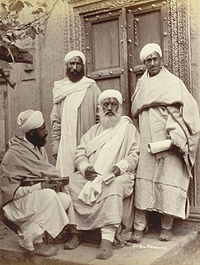Kashmiri Hindu
 |
|
| Total population | |
|---|---|
| 160,000-170,000 (est. living in Kashmir Valley prior to 1990) | |
| Regions with significant populations | |
|
India (Jammu and Kashmir • National Capital Region • Uttar Pradesh • Himachal Pradesh • Uttarkhand • Haryana • Rajasthan • Punjab) |
|
| Languages | |
| Kashmiri and Hindi | |
| Religion | |
|
|
|
| Related ethnic groups | |
| Dards, Hindustani people, Indo-Aryans, Saraswat Brahmins, Indo-Caribbeans, Indo-Caribbean Americans |
The Kashmiri Pandits (also known as Kashmiri Brahmins) are a Shaivite Saraswat Brahmin community from the Kashmir Valley, a mountainous region in the Indian state of Jammu and Kashmir. They are the only remaining Hindu community native to the Kashmir Valley.
The Hindu caste system of the Kashmir region was influenced by the influx of Buddhism from the time of Asoka, around the third century BCE, and a consequence of this was that the traditional lines of varna were blurred, with the exception of that for the Brahmins, who remained aloof from the changes. Another notable feature of early Kashmiri society was the relative high regard in which women were held when compared to their position in other communities of the period.
A historically contested region, Northern India was subject to attack from Turkic and Arab regimes from the eighth century onwards, but they generally ignored the mountain-circled Kashmir Valley in favour of easier pickings elsewhere. It was not until the fourteenth century that Muslim rule was finally established in the Valley and when this happened it did not occur primarily as a consequence of invasion so much as because of internal problems resulting from the weak rule and corruption endemic in the Hindu Lohara dynasty. Mohibbul Hasan describes this collapse as
The Dãmaras (feudal chiefs) grew powerful, defied royal authority, and by their constant revolts plunged the country into confusion. Life and property were not safe, agriculture declined, and there were periods when trade came to a standstill. Socially and morally too the court and the country had sunk to the depths of degradations.
The Brahmins had something to be particularly unhappy about during the reign of the last Lohara king, for Sūhadeva chose to include them in his system of onerous taxation, whereas previously they appear to have been exempted.
Zulju, who was probably a Mongol from Turkistan, wreaked devastation in 1320, when he commanded a force that conquered many regions of the Kashmir Valley. However, Zulju was probably not a Muslim. The actions of Sultan Sikandar Butshikan (1389–1413), the seventh Muslim ruler in Kashmir were also significant to the area. The Sultan has been referred to as an iconoclast because of his destruction of many non-Muslim religious symbols and the manner in which he forced the population to convert or flee. Many followers of the traditional religions who did not convert to Islam instead migrated to other parts of India. The migrants included some Pandits, although it is possible that some of this community relocated for economic reasons as much as to escape the new rulers. Brahmins were at that time generally being offered grants of land in other areas by rulers seeking to utilise the traditionally high literacy and general education of the community, as well as the legitimacy conferred upon them by association. The outcome of this shift both in population and in religion was that the Kashmir Valley became a predominantly Muslim region.
...
Wikipedia
